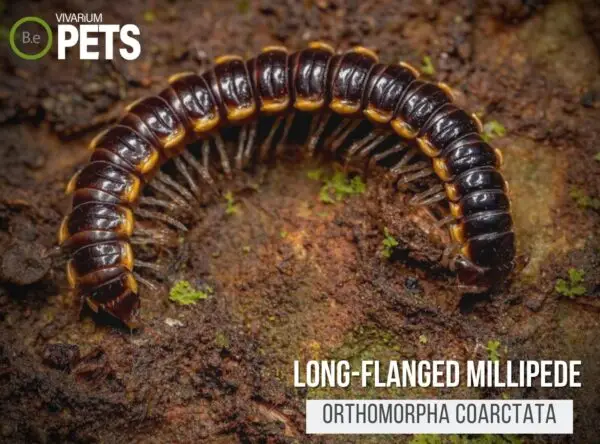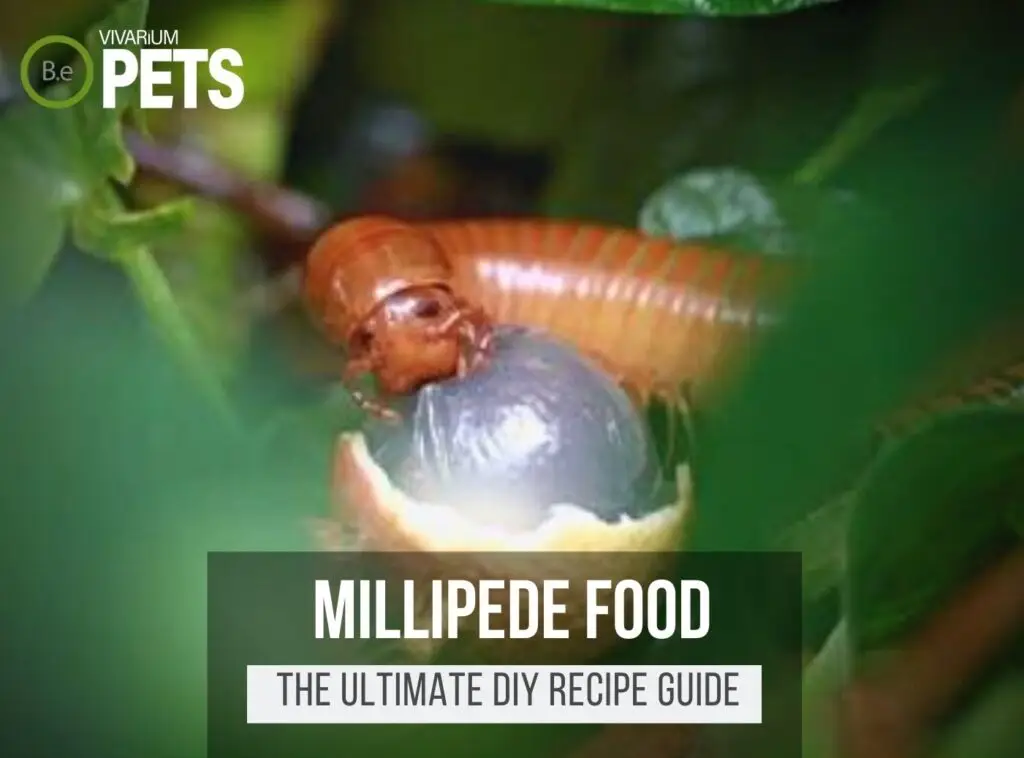Are you interested in learning more about one of the most fascinating species of millipedes – the Long-Flanged Millipede (Orthomorpha coarctata)?
These strange creatures are known for their unique appearances with multiple legs and long, unusual flanges which make them interesting to look at and keep as pets.
Whether you’re a beginner or an experienced millipede enthusiast, this guide is perfect for providing all the information you need to keep them healthy and happy living in your home.
Here’s all you need to know about this unique millipedes care!
| Characteristics: | |
|---|---|
| Common Name | Long-Flange Millipede |
| Family Name | Paradoxosomatidae |
| Scientific Name | Orthomorpha coarctata, Asiomorpha coarctata |
| Use | Cleaning, Aerating Soil, Pets |
| Temperament | Non-aggressive |
| Lifespan | 8+ Years |
| Diet | Detritivore |
| Adult Size | 2.7 cm |
| Breeding Type | Egg Layer |
| Care Level | Easy |
| Minimum Tank Size | 5-10 Gallons |
| pH | 7.0-8.4 |
| Hardness | Moderate |
| Temperature | 60-75°F |
Table Of Contents:
ToggleWhat Are Long-flanged Millipedes?
Long-flanged millipedes, also known as Orthomorpha coarctata, are a type of invertebrate belonging to the family Paradoxosomatidae.
Their common name comes from these distinctive long flanges on their bodies, which range from a few centimeters in length.
While these small millipedes may look intimidating, they are generally quite harmless and can make excellent pets for those curious about the invertebrate world.
What Do Long-flanged Millipedes Look Like?
Orthomorpha coarctata is a species of millipede that stands out from the rest with its peculiar appearance.
These millipedes are brownish-black in color and measure from 2.5 to 2.7 centimeters in length when fully grown.
They have a large number of body segments, each of which is covered in short spines.
Its most distinctive feature is the two long flanges running down the entire length of its body.
These have a few bristles and scales on them, giving them a textured appearance.
The Long-Flanged Millipede is also known for its many legs, which can range from 30 to 100 pairs.
All of these legs are highly mobile and are used to quickly move the millipede around its environment.
Its head has two antennae and two simple eyes, making it good at detecting nearby prey and sensing the environment around it.
Benefits Of Using Long-flanged Millipedes
The Long-Flanged Millipede is an intriguing creature and a great addition to many types of vivariums.
Not only do they add an interesting dynamic, but they also serve practical purposes like soil aeration, natural leaf litter cleanup, and pest control.
Additionally, they can survive in a wide range of temperatures and climate levels, making them easy to care for and an ideal fit for any self-sustaining environment!


Long-flanged Millipede Facts
Long-Flanged Millipedes are scientifically known as Orthomorpha coarctata but were previously labeled Asiomorpha coarctata.
They are native to regions of Southeast Asia and have a diet consisting mainly of decaying vegetable matter.
These Millipedes have a peaceful temperament, a lifespan of up to 8 years, and breed mainly during the monsoon season.
They are relatively easy to care for, as long as their needed environment and diet are provided.
Habitat
The Long-Flanged Millipede is a species of millipede native to Java, located in Indonesia.
They are an arboreal species, which means they inhabit and climb trees in their natural environment.
Their home ecosystem typically consists of lush, tropical rainforests filled with a lot of dense foliage that provides the ideal cover and food sources for Orthomorpha coarctata.
These millipedes are usually found among decaying logs and thick forest floor litter, and they usually hide in narrow crevices or tiny holes during the daytime.
As a nocturnal species, they become active during the night and scavenge for food in and around the foliage.
Diet
In the wild, Orthomorpha coarctata feeds primarily on dead vegetation. This includes leaves, bark, wood, and sometimes fungi and mold.
They are omnivores and scavengers that will also feed on small insects, worms, and decaying fruits and vegetables.
When given the opportunity, they will also feed on live plant matter such as live moss and decaying roots.
Temperament
Long-flanged millipedes are shy and gentle creatures that usually prefer to hide from humans and other animals.
While they are not necessarily dangerous, they can sometimes flick their legs and/or secrete a foul-smelling liquid in defense when disturbed.
When properly handled, however, millipedes are harmless and docile animals that are not aggressive toward people.
They generally prefer to stay away from humans and other animals when at all possible, including other millipedes.
Orthomorpha coarctata is also known to be largely solitary and prefers to stay in its hiding places separated from other millipedes.
Lifespan
The lifespan of Long-flanged Millipedes is usually between 3-6 years, although some individuals have been known to live for up to 8 years.
Like most millipedes, Orthomorpha coarctata go through a multi-stage life cycle. The stages include egg, juvenile, and adult.
Once the eggs hatch, the juveniles then grow and molt several times over a few months before they become adults.
During the adult phase, Long-flanged Millipedes can reproduce and lay eggs, thus beginning another cycle.
Breeding
When it comes to mating and reproduction, the Long-flanged Millipede is an outlier amongst other species of millipede.
The female Long-flanged Millipede can produce anywhere from 2-8 offspring from a single clutch of eggs.
The egg-shaped capsules formed during this process will usually hatch within 6-12 weeks.
Orthomorpha coarctata reproduce several times during their lifespan, each time producing a roughly equal number of offspring.
Where To Find Long-flanged Millipedes
Long-flanged millipedes can be found in the wild in tropical areas of Asia, usually in moist and humid rainforests.
They tend to prefer areas of dense vegetation and dark, cool places for hiding.
If you want to find them in the wild, you’ll need to spend some time searching through the undergrowth, such as decaying logs and leaf litter.
These millipedes are also available for sale from pet stores, exotic pet breeders, or online retailers.
Be sure to choose specimens that are active and alert; ones that appear sluggish or have any visible lesions should be avoided.
Long-flanged Millipede Care
Long-flanged Millipedes must be kept in an environment with proper humidity and heat levels.
They should be fed a diet of plants and rotting wood, supplemented with calcium and nutritious snacks.
Care should also be taken to ensure their enclosure is safe from predators and their habitat is properly cleaned.
Lastly, check regularly for signs of illness and take proactive steps to prevent and treat common health issues.
Tank Requirements
Orthomorpha coarctata is best kept in enclosures that are low humidity, cool, and well ventilated such as glass or plastic terrariums.
The optimal pH should be between 6.5-7.5, the temperature should be kept between 55-77°F (13-25°C) and the hardness should be soft to medium.
A suitable terrarium soil for these millipedes can include coco fiber soil and peat moss, with a two-inch layer at the base of the enclosure.
Terrarium lighting is not essential, however, if you opt to include it, get a timed day/night cycled light and place it at one end of the enclosure to give them a place to rest under.
What Do Long-flanged Millipedes Eat?
Feeding your Long-Flanged Millipede is an essential part of their care regimen.
The primary diet of these creatures consists of fruits, vegetables, leafy greens, and other nutrient-packed food sources.
For a standard diet, you can feed them a variety of foods such as:
- Fruits: Apples, oranges, bananas, strawberries, etc.
- Vegetables: Carrots, lettuce, kale, spinach, etc.
- Leafy Greens: Dandelion greens, clover, grasses, etc.
- Protein Sources: Small insects, mealworms, waxworms, etc.
- Other Nutritious Foods: Dog food, fish flakes, nuts, etc.
Ensure that the food you give them is fresh and contains all the nutrients they need for a healthy and happy life.
Long-Flanged Millipedes should also have access to water, either in the form of a shallow water dish or by misting their enclosure lightly with water.
If you’re more of an avid hobbyist like myself, be sure to check out my ultimate DIY Millipede food guide. I give a more in-depth explanation of the best foods and my favorite recipe.
Best Tankmates For Long-flanged Millipedes
When it comes to keeping Long-flanged Millipedes, the best tankmates are animals with similar beneficial qualities similar to the millipedes themselves.
This includes other invertebrates such as earthworms, isopods, and springtails.
These tankmates can provide companionship and help to keep the environment healthy and clean.
They also aid in the activity of burrowing in the substrate as millipedes do.
As with other tank mates, be sure to research species compatibility before introducing them.
Additionally, make sure the tank size and temperature are suitable for the other species as well.
Conclusion
We hope that this guide has provided you with all you need to know about keeping Long-Flanged Millipedes as happy, healthy pet millipedes in your home.
From habitat and environment requirements to diet, nutrition, and maintenance… It is essential to fulfilling their needs to provide them with the best possible quality of life.
With the right knowledge and a bit of dedication, your Orthomorpha coarctata will thrive in your care!
Frequently Asked Questions
There is limited information available on whether Orthomorpha coarctata produces hydrogen cyanide, but some millipedes are known to secrete this toxic chemical as a defense mechanism.
Therefore, it’s possible that Orthomorpha coarctata may have the ability to produce hydrogen cyanide as well.

